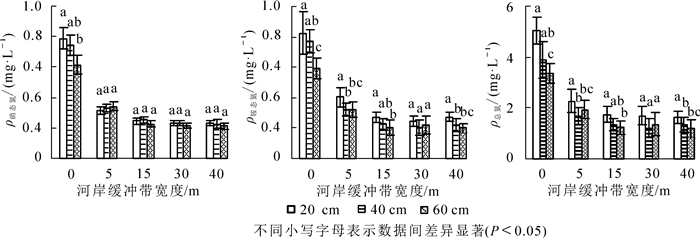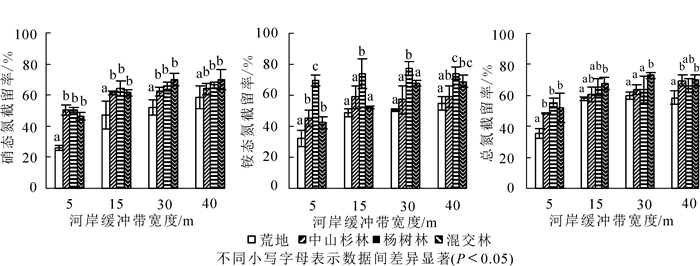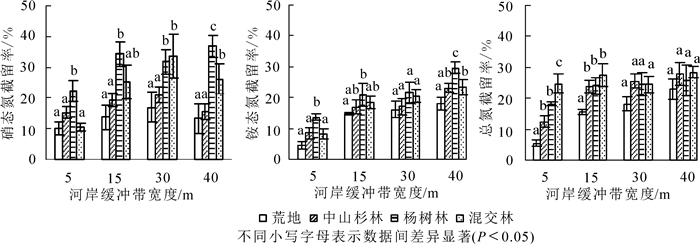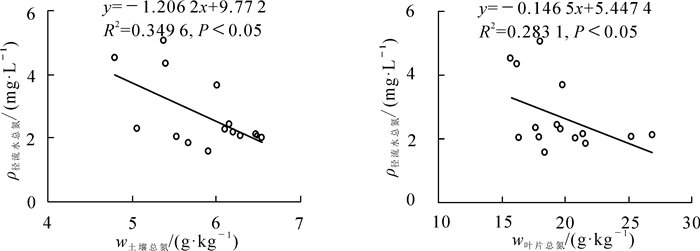-
随着社会经济与城市化的快速发展,人类活动造成的水体污染已成为全球重要的环境污染问题之一。面源污染是水体污染的主要表现形式之一,而农业面源污染是面源污染的主要来源[1]。作为农业大国,中国化肥使用量逐年增长。据统计,2015年全年使用量已高达6 022.6万t,农用化肥单位面积平均施用量已达458.6 kg·hm-2,是安全上限(225 kg·hm-2)的2.04倍,但化肥利用率仅为30%~40%[2],导致化肥中大部分营养元素进入水体,造成水体氮、磷污染。因此,如何治理农业面源污染已成为目前环境治理的重难点问题。许多研究表明:位于水陆交界处的河岸植被缓冲带可以有效截留和清除面源污染中的氮磷[3-6],被认为是控制非点源污染的最佳管理措施之一[7]。河岸植被缓冲带通过沉积、土壤吸附、植物吸收、反硝化作用和微生物固定等途径,有效截留和清除氮等面源污染物质。目前,国内外学者在河岸缓冲带氮素截留方面已做了诸多研究。SPRUILL[8]对小流域的河岸植被缓冲带进行研究时,发现其能移除地表水中95%以上的氮元素,其中反硝化作用去除的氮元素占65%~70%;KOVACIC等[9]研究发现:森林和草地河岸缓冲带对浅层地下水中硝态氮的截留率达90%以上,其中森林河岸缓冲带对硝态氮的截留转化能力高于草地河岸缓冲带;WANG等[10]研究表明:林地和草地缓冲带主要通过显著减少土壤表面径流量有效去除水分和养分。国内研究起步虽然较晚,但也取得了一些成果。陈金林等[11]研究发现:农田与沟渠间的缓冲林带有利于截留和净化土壤径流中的氮、磷等物质,不同林带宽度对农业非点源污染的防治效果不同;王庆成等[12]研究表明:农田背景下的森林河岸带土壤反硝化强度最大,硝态氮消失率的变化范围为46.79%~91.13%,且河岸带表层土壤的反硝化强度大于底层;林晓晟[13]在流域尺度上利用有限元数值模技术构建了HYDRUS2D/3D模型,提出丘陵区河岸缓冲带的宽度为15~60 m,平原区河岸缓冲带宽度为5~20 m,可有效截留氮、磷污染物。总体而言,学者大多基于景观甚至流域尺度上研究河岸植被缓冲带的功能及其影响因素,很少在林分水平上开展缓冲带削减面源污染的研究。且在有关湖泊周围地势较为平坦的河岸缓冲带截留养分和沉积物的研究较少[14]。因此,本研究以太湖不同宽度的林地河岸缓冲带为对象,研究其对径流水及土壤中氮素截留效果的影响,以期为适宜河岸缓冲带宽度的设计提供参考。
-
研究区位于江苏省宜兴市周铁镇沙塘港村(31°07′~31°37′N,119°31′~120°03′E),该区紧邻太湖。气候类型为亚热带季风气候,温和湿润,雨水充沛,四季分明。主导风向为东南风,无霜期239 d,年平均气温为15.7 ℃,年均日照时数为1 924.2 h,作物生长季积温5 475.8 ℃。降水集中在春季和夏季,6和8月多暴雨。年均降水量为1 177.0 mm。地表、地下水丰富。研究区土壤为中性黄壤,土质均匀,土壤容积密度为1.38 g·cm-3,样地坡度比为1:250。周边居民主要以农业为主,主要种植水稻Oryza sativa,小麦Triticum aestivum和油菜Brassica napus等农作物。
-
在样地设置4个20 m × 50 m的小区,小区之间间隔5 m,并用宽60 cm,厚1.5 cm的复合板分隔,避免相互干扰(图 1)。小区平行排列,依次为荒地、1 000株·hm-2的中山杉Taxodium hybrid ‘Zhongshanshan’-‘南林95’杨Populus × euramericana‘Nanlin 95’混交林、1 000株·hm-2的中山杉林和1 000株·hm-2的杨树林。所选树种为太湖流域常见树种,树龄均为5 a,杨树平均树高为4.0 m,胸径为5.0 cm,平均冠幅为135 cm,中山杉平均树高为3.0 m,胸径为4.0 cm,冠幅为105 cm。在每个样地小区距样地起始端(沿径流水方向)0,5,15,30,40 m宽度处分别埋设3组聚氯乙烯淋溶管,3个·组-1,深度分别为20,40和60 cm,用于径流水样的采集。
在每块样地小区前0至0.5 m处,参照当地农田施肥量进行施肥,模拟氮素流失状况。所施复合肥氮磷钾比例为16:8:16,施肥量为48 kg·hm-2。在降雨前施肥,降雨产流后采样,施肥与采样间隔1周。样品采集选择在当地的雨季(4-9月)进行采集,3次采样时间分别是2016年4月21-23日,7月9-11日以及9月23-24日。采样期间前1周平均降水量分别为57.7,87.7和72.6 mm。
-
用小型泵在各样地小区分别抽取不同宽度处20,40和60 cm深淋溶管内径流水样,装入250 mL塑料瓶中,带回实验室,放入-4~0 ℃冰箱内进行保存,及时测定水样中不同形态氮质量浓度。每次采样结束后,将淋溶管内的水抽空,方便下次采集,并在远离样地的地方倾倒。取水样后,在不同宽度的每组淋溶管所在区域,选取1 m × 1 m的范围,用土钻采集0~5,5~20和20~40 cm等3个不同深度的土样,分别装入塑料袋内,带回实验室检测。
水样总氮(TN)的测定采用GB 11894-1989《水质总氮的测定碱性过硫酸钾消解紫外分光光度法》测定;待测铵态氮(NH4+-N)和硝态氮(NO3--N)的水样先经过0.45 μm滤膜抽滤预处理,再分别使用HJ 535-2009《水质氨氮的测定纳氏试剂分光光度法》和HJ/T 346-2007《水质硝酸盐氮的测定紫外分光光度法(试行)》进行测定。土样铵态氮、硝态氮是利用鲜土分别采用HJ 535-2009《水质氨氮的测定纳氏试剂分光光度法》和HJ/T 346-2007《水质硝酸盐氮的测定紫外分光光度法(试行)》进行测定。土壤总氮(TN)是土样经风干、过筛后,用元素分析仪测定。
-
用Excel 2010对数据进行处理;用SPSS 20.0对数据进行单因素方差分析和Pearson相关性分析。取3次数据采样平均值进行分析。
-
随着河岸缓冲带宽度的增加,径流水中硝态氮、铵态氮和总氮质量浓度逐渐降低(图 2),截留率逐渐上升(图 3)。其中,对铵态氮的截留率最高,其次是硝态氮,对总氮的去除率最低。经过40 m的河岸缓冲带后,对径流水中硝态氮、铵态氮和总氮的平均截留率分别达68.69%,68.81%和66.01%。说明不同宽度的河岸缓冲带对径流水中的氮素有一定截留效果。对各深度径流水中氮质量浓度与缓冲带宽度进行单因素分析表明:前15 m径流水中硝态氮、铵态氮和总氮质量浓度随宽度变化差异显著(P<0.05),15 m后不显著(P>0.05)。说明15 m宽的河岸缓冲带能很好地截留径流水中的硝态氮、铵态氮和总氮。随着深度的增加,径流水中氮素质量浓度总体呈降低趋势,说明土壤吸附和植物吸收在径流水下渗过程中起到了一定的截留作用。对不同深度径流水中氮素质量浓度进行差异性分析表明:硝态氮质量浓度在5 m以后随深度变化差异不显著(P>0.05);各宽度铵态氮质量浓度在20与60 cm深度差异显著(P<0.05);总氮质量浓度在30 m之前20 cm与40,60 cm深度差异显著(P<0.05),30 m之后不显著。就截留率而言,不同深度径流水中硝态氮的截留率从高到低依次为20,40,60 cm;对铵态氮和总氮的截留率从高到低依次为40,20,60 cm。
-
从图 4可看出:乔木林河岸缓冲带对径流水中氮素的截留率均显著高于荒地(P<0.05);其中杨树林在前15 m对硝态氮的截留率最高(64.37%),15 m后混交林对硝态氮的去除率最高,并在40 m处达最大值(69.92%),但与杨树林、中山杉林截留率差异不显著(P>0.05)。不同宽度下,杨树林对铵态氮的截留率最高,且与中山杉林、混交林截留率差异显著(P<0.05),并在30 m处截留率达最大值(77.4%)。15 m及其以上的混交林对径流水总氮截留率最高,并在30 m处达最大值(73.0%)。在30 m宽度处混交林与杨树林和中山杉林对径流水中总氮的截留率之间差异显著(P<0.05)。
-
随着缓冲带宽度的增加,土壤氮素质量分数总体上呈增加趋势(图 5),表明随着缓冲带宽度的增加,氮素被更多地滞留在土壤中,起到了较好的截留作用。土壤中硝态氮、铵态氮和总氮的质量分数在前15 m随宽度变化差异性显著(P<0.05),15 m后差异不显著(P>0.05),说明缓冲带前15 m截留了大部分氮素。经过40 m河岸缓冲带后,土壤中硝态氮、铵态氮、总氮的平均截留率分别达37.75%,24.20%和28.53%(图 6)。在15 m及以后,0~5 cm深土壤中硝态氮质量分数较高,且在15和30 m处与5~20,20~40 cm深土壤硝态氮质量分数差异显著(P<0.05)。各宽度不同深度土壤中铵态氮质量分数从大到小依次为0~5,5~20,20~40 cm,但差异不显著(P>0.05)。0~5 cm深度土壤中总氮质量分数最高,且在15和30 m宽度处与20~40 cm深土壤中总氮质量分数差异显著(P<0.05)。就截留率而言,河岸植被缓冲带对硝态氮的截留效果最好,其次为总氮,铵态氮截留率最低。不同深度土壤中,3种氮素截留率随着河岸缓冲带宽度的增加均以15 m为节点,先上升后下降或缓慢上升,其中硝态氮和铵态氮截留率下降后在40 m处达最大值。可能是由于前15 m缓冲带截留了绝大部分氮素,导致径流水氮素质量分数大幅下降,从而被土壤吸附的量减少,截留率下降;在各宽度处,5~20 cm深土壤对硝态氮和铵态氮截留率较高,而土壤对总氮的截留率从大到小依次是0~5,20~40和5~20 cm。
-
从图 7可看出:乔木林(中山杉林、杨树林、混交林)对土壤中氮素的截留率均高于荒地,且随着缓冲带宽度的增加,截留率基本都呈上升趋势,说明林地对径流水中的氮素起到了很好的截留效果。不同宽度处,杨树林对硝态氮和铵态氮的截留率均高于中山杉和混交林,且均在40 m处达最大值(36.87%和29.71%),其中杨树林对硝态氮的截留率要高于对铵态氮的截留率。在各缓冲带宽度处杨树林对硝态氮的截留率与中山杉林差异显著(P<0.05),但与混交林差异不显著(P>0.05);杨树林在5和40 m处对铵态氮的截留率与中山杉林、混交林差异显著(P<0.05)。对于总氮来说,混交林对总氮的截留率最高,在40 m处达最大值(28.47%),但在各宽度处对总氮的截留率与中山杉林和杨树林差异不显著(P>0.05)。
-
相关分析表明:土壤中总氮质量分数与径流水中总氮质量浓度呈显著负相关(P<0.05,图 6),说明土壤对径流水中氮素的截留起到了积极的作用,有效降低了径流水中总氮质量浓度;植物叶片总氮与径流水中总氮的质量浓度相关性不显著,但呈一定负相关关系(图 8)。
-
本研究发现:随着河岸缓冲带宽度的增加,径流水中氮素的质量浓度不断降低,氮素截留率不断上升,但在15 m后氮素的截留效率上升不明显,且与40 m处氮素截留率相近,即随缓冲带宽度的增加,单位宽度缓冲带氮素截留率先升高后降低,15 m宽缓冲带即可显著降低经流水中氮素,这与SYVERSEN[15]研究中单位宽度缓冲带氮素截留率随宽度增加先升高后降低的结果一致。赵警卫等[16]、孟亦奇等[17]也认为:15 m后缓冲带氮素截留率上升不明显,但与汤家喜[18]提出的9 m缓冲带宽度即可显著减少经流水中氮素含量不同,主要因为其研究地土壤为砂质土壤,固氮能力较强的草本植物占优势,这从另一方面也说明了土壤物理性质对缓冲带功能的影响。土壤中氮素质量分数和截留率均呈现先升高后降低的趋势,并且在前15 m质量分数变化显著,在15 m后变化不显著,与郭鑫[19]研究中土壤氮素截留率随缓冲带宽度增加先升高后降低的结果一致,可能是由于前15 m缓冲带截留了绝大部分氮素,导致径流水氮素质量分数大幅下降,从而被土壤吸附的量减少,截留率下降。综上所述,15 m宽的河岸缓冲带能够有效截留氮素污染物,这与王敏等[20]、于红丽[21]认为的15 m宽河岸缓冲带即可有效截留氮素的结果一致。BORIN等[22]则认为6 m宽的河岸缓冲带即能有效去除径流水中的氮,而李怀恩等[23]认为缓冲带对氮素的截留作用主要发生在前10 m。植被组成、坡度、土壤理化性质、水文过程以及气候等因素的不同,均会导致有效截留氮素的宽度差异。因此,针对不同的地域环境,要综合考虑不同的影响因子,建立适宜的缓冲带宽度。
不同宽度缓冲带处径流水和土壤中氮素的含量随深度的加深呈降低趋势,说明土壤在径流水下渗的过程中起到了一定的截留作用,截留吸附了径流水中部分氮素。其中径流水中硝态氮质量浓度随深度变化差异不显著,铵态氮、总氮随深度变化差异显著,这与黄玲玲[24]研究中土层越深土壤总氮浓度越低的结果一致,主要是因为硝态氮极易溶于土壤水中而向更深层的土壤淋溶[25],在降雨过程中,在雨水的溶解下迅速向60 cm或更深的土层淋溶,而导致0~60 cm硝态氮含量差异不大。就去除率而言,缓冲带对40 cm深径流水中铵态氮、总氮的截留率较高,对20 cm深的硝态氮截留率较高;而缓冲带5~20 cm深土壤铵态氮和硝态氮的截留率较高,主要是因为铵态氮通过硝化作用,在0~5 cm深土壤总氮截留率较高,说明土壤对总氮的截留主要发生在土壤表层,而对硝态氮和铵态氮的截留主要发生在土壤中层。
有研究表明:缓冲带不同的植物配置对氮素污染的净化效果不同[26]。本研究中,3种河岸植被缓冲带对氮素的截留能力均高于对照,表明不同植被类型河岸缓冲带对径流水中氮素均起到较好的截留效果。杨树林缓冲带对径流水中铵态氮和硝态氮的截留率较高,其中对径流水中铵态氮的截留率与中山杉林和混交林差异显著(P<0.05),对径流水中硝态氮的截留率与中山杉林和混交林差异不显著;混交林缓冲带对总氮的截留率较高,但与杨树林和中山杉林的截留率差异不显著(P>0.05)。主要由于阔叶林可以显著增加土壤有机质的积累,而针叶林对土壤有机质积累的影响较弱,尤其是杉木Cunninghamia lanceolata纯林对土壤有机质的累积作用缓慢[11],同时,杨树根系比中山杉根系深[17],能够更多地吸收淋溶到深层土壤中的硝态氮,且样地树种处于幼龄阶段,杨树的生长速度较中山杉和混交林快,需要吸取更多的养分,这可能是造成杨树林缓冲带对径流水中铵态氮、硝态氮有较高截留率的主要原因。同时,不同缓冲带宽度处杨树林叶片全氮含量均高于中山杉林和混交林可能亦与此有关。
相关分析表明:土壤中总氮质量分数与径流水中总氮质量浓度呈显著负相关(P<0.05),且土壤中硝态氮的截留率最高,说明土壤吸附和反硝化作用是径流水中氮素截留去除的主要途径。从截留率来说,径流水中氮素截留率为66.01%~68.81%,土壤对氮素的截留率为24.20%~37.75%,占径流水中氮素截留率近一半,说明土壤对径流水中氮素的截留起到了积极的作用,有效降低了径流水中总氮质量浓度。
Removing nitrogen with trees planted in the riparian vegetation buffer strips of Taihu Lake
-
摘要: 为研究河岸植被缓冲带对氮素的截留效率,以太湖流域平缓坡地上人工林河岸缓冲带作为研究对象,分析了不同河岸缓冲带宽度(5,15,30,40 m),不同植物类型(‘南林95’杨Populus×euramericana ‘Nanlin 95’林、中山杉Taxodium hybrid ‘Zhongshanshan’林、南林杨95-中山杉混交林)对不同深度径流水及土壤中氮素的截留效果。结果表明:15 m宽的河岸缓冲带即能很好地截留各形态氮素,40 m缓冲带对径流水中硝态氮、铵态氮、总氮的截留率分别达68.8%,68.7%和66.0%;同一宽度条件下,缓冲带对40 cm深径流水中铵态氮、总氮的截留率较高,分别达71.4%和69.1%,对20 cm深径流水中硝态氮截留率较高,达70.6%;森林土壤对铵态氮和硝态氮的截留主要在中层土壤,对总氮截留主要在表层土壤;杨树林缓冲带对径流水中铵态氮和硝态氮的截留率较高(P < 0.05),达77.4%和66.3%;杨树-中山杉混交林缓冲带对总氮的截留率较高(P < 0.05),达73.0%;植物叶片(r=-0.53)全氮和土壤总氮(r=-0.59)均与径流水中总氮呈负相关关系。Abstract: In the Taihu Lake area many riparian vegetation buffer strips have been built to alleviate the input of eutrophic nutrients into the lake. To provide a scientific basis for determining a suitable width and components of these riparian buffer strips, the effects of riparian vegetation buffer strips with widths of 5, 15, 30, and 40 m and vegetation types of a Populus×euramericana 'Nanlin 95' plantation, an Taxodium hybrid 'Zhongshanshan' plantation, and a mixed plantation with the two tree species on total nitrogen, ammonia nitrogen, and nitrate nitrogen removal rates for different depths of runoff water and soil were studied. Results showed that the buffer strips of 15 m width effectively removed various fractions of N and removal rates in runoff water of 40 m width of 68.8% for NO3-, 68.7% for NH4+, and 66.0% for total N. Removal rates of NH4+ and total N in runoff water at 40 cm below ground level were higher, reached 71.4% and 69.1%, but NO3- removal rate in the 20 cm depth of runoff water was higher, reached 70.6%. The interceptions of NH4+ and NO3- in plantation soils were mainly in the middle soil layer, and total N was trapped mainly in surface soils. The poplar plantation had a higher removal rate of NH4+ and NO3- in runoff water(P < 0.05), reached 77.4% and 66.3%, but the mixed forests of the poplar plantation and Taxodium hybrid 'Zhongshanshan' plantation had a higher removal rate of total N(P < 0.05), reached 73.0%. Also, total N in runoff water was negatively correlated to total N in the soil (r=-0.59) and total N in the leaves (r=-0.53) of plants.
-
Key words:
- forest ecology /
- riparian vegetation buffer strip /
- width /
- vegetation type /
- nitrogen /
- removal rate
-
随着经济和工业化的发展,酸雨污染日益成为中国重要的环境问题[1]。ZHAO等[2]和杨东贞等[3]发现:1999-2006年浙江省杭州市临安地区降水中除硫酸根离子(SO42-)外,硝酸根离子(NO3-)亦明显增加,尤其是2001年后NO3-对降水酸度的贡献逐步加大,降雨属于硫酸与硝酸混合型酸雨[4]。研究认为:酸雨抑制植物养分、水分的吸收和运输,导致植物无法正常生长[5-7]。酸雨可直接破坏叶肉细胞结构,使叶片细胞膜通透性增大,细胞膜保护酶的活性下降,膜脂过氧化作用加剧,植物体内清除活性氧平衡被打破,从而影响光合、呼吸以及代谢等生理生化进程而使植物受害[8-10]。秃瓣杜英Eleocarpus glabripetalus系杜英科Elaeocarpaceae杜英属Elaeocarpus常绿乔木,适于中性或微酸性的山地红壤、黄壤上生长,是亚热带地区常见树种,常在评价酸雨对亚热带地区森林系统影响时作为试材。研究发现:模拟酸雨处理下秃瓣杜英的生物量积累[11-12]、PSⅡ原初光能转化效率和PSⅡ潜在活性均有所上升[11]。俞飞等[13]则发现:不同酸雨处理下,杜英应对酸雨胁迫的途径不同。目前,有关酸雨影响植物生理与养分的研究较多,但对酸雨影响杜英生理和养分元素分配的协同探索较少,因此,本试验在研究不同酸雨梯度影响秃瓣杜英幼苗PSⅡ反应中心和幼苗养分分配的基础上,进一步探索秃瓣杜英幼苗响应酸雨胁迫的机制,为生物响应酸雨胁迫研究提供依据和参考。
1. 材料与方法
1.1 实验地概况
试验地位于浙江省杭州市临安区浙江农林大学平山试验基地大棚(30°16′N,119°44′E)。属于中亚热带季风气候,温暖湿润,四季分明,年平均降水量约1 400.0 mm,全年平均气温为16.4 ℃,年无霜期250.0 d左右。区域森林覆盖率为76.5%。土壤类型为红壤。
1.2 试验方法
1.2.1 试验材料
选取高度为40~60 cm的1年生秃瓣杜英幼苗,于2011年1月移栽到高40 cm,直径30 cm的塑料花盆中,采用试验地红黄壤作为栽培土。幼苗随机分成10组,7株·组-1,苗木编号、挂牌后置于智能温室大棚内,保持棚内温度23~33 ℃,湿度55%~75%。缓苗期间用自来水浇灌,常规管理,2011年3月开始模拟酸雨喷洒[14]。模拟酸雨采用喷雾法,隔3 d喷洒1次,处理期间植物不浇水。
1.2.2 试验设计
参照该地区酸性降水中平均离子组成和试验通用配比,按V(H2SO4):V(HNO3)=8:1配制母液,再用蒸馏水稀释成pH 2.5,pH 4.0及pH 5.6的酸雨水溶液,作为重度酸雨处理(T2.5),中度酸雨处理(T4.0)和轻度酸雨处理(T5.6)[15]。根据临安区近10 a平均降水量统计数据[13],计算每个酸雨等级所需的酸雨量,同时以等量的清水浇灌幼苗作为对照组(ck)。
1.3 测定方法
1.3.1 叶绿素荧光参数测定
2015年7月晴朗天气的9:00-11:00采用便携式叶绿素荧光仪(PAM-2100,Walz,德国)测定初始荧光值(Fo),黑暗中最大荧光值(Fm),实时荧光值(Ft),最大光化学量子产量光系统Ⅱ(PSⅡ)的最大光化学效率(Fv/Fm),实际光化学量子产量(Yield),光化学猝灭系数(qP)等叶绿素荧光参数。随机选取5株·处理-1,并在每株不同方位中上部随机选取5片成熟叶片进行测定。所得数据为3 d的平均值。
1.3.2 叶绿素相对含量的测定
选取进行荧光测定相同的叶片,用便携式叶绿素含量测定仪(SPAD-502,日本)测定叶绿素相对含量,测定3次·叶片-1,以5个叶片作为各组的平均值。
1.3.3 植物矿质元素的测定
2015年8月初,选择之前进行荧光实验的5株植株,各植株上中下各部位采集秃瓣杜英叶3片。幼苗叶氮元素质量分数用半微量凯式定氮法测定,磷元素质量分数用钼锑抗比色法测定[16-17];钾、镁元素利用电感耦合等离子体发射光谱仪(PerkinElmer Inc.,美国)进行测定[18]。
1.3.4 生物量的测定
2015年11月全株收获,将黏附于秃瓣杜英幼苗上的泥土和污物用水冲洗干净,105 ℃下杀青5 min后,60 ℃下于烘箱中烘至恒量,分别称量地上部分和地下部分的生物量。
1.3.5 土壤元素的测定
将取回来的土样自然风干后磨碎,过100目筛。取各处理的土壤样品0.15 g预消解过夜,移入微波消解仪中消解至变色。得到的澄清、透明溶液摇匀静置待测,同时制备空白[19]。用电感耦合等离子体发射光谱仪测定金属铜和金属锌的质量分数,重复3次·样品-1。
1.3.6 转移系数和生物富集系数
转移系数(TF)可以表征植物地上部分金属与根部中金属质量分数的比值[20],表示如下:转移系数=地上部分金属质量分数/根部金属质量分数。生物富集系数(BCF)是植物体内某种金属元素的质量分数与土壤内该种金属元素的总质量分数之比[20],表示如下:富集系数=植物体内金属元素质量分数/土壤内金属元素质量分数。
1.4 数据处理
用SPSS 16.0软件统计秃瓣杜英幼苗的生长参数、叶绿素相对含量、荧光参数以及植株和土壤元素,对所有数据进行正态性与齐性检验后,利用单因素方差分析(one-way ANOVA)和最小显著差法(LSD)比较不同数据组间的差异,用Excel软件作图。
2. 结果与分析
2.1 不同酸雨梯度对幼苗叶绿素参数的影响
由图 1可知:酸雨处理组的叶绿素相对含量均高于对照组,且叶绿素相对含量随着酸雨pH值的降低而升高,但是各处理组与对照组间差异不显著(P>0.05)。Fv/Fm的变化跟叶绿素相对含量一致,也是随着酸雨pH值的降低而升高的,但各处理组与对照组之间均有显著差异(P<0.05),T5.6,T4.0和T2.5分别较对照组升高4.22%,6.07%和6.86%,说明酸雨有利于叶片PSⅡ原初光能转化效率的提高。同样地,Yield和qP也是随着酸雨pH的降低而升高,其中重度酸雨处理组Yield显著高于对照组(P<0.05),重、中度酸雨处理组qP显著高于对照组(P<0.05)。
2.2 不同酸梯度对幼苗生物量的影响
由图 2可知:地上部生物量最高的是对照组,随着酸雨pH值的降低,各处理组的地上部生物量相比对照组分别降低了29.27%,4.88%和26.83%;根系生物量最低的是对照组,随着酸雨pH值的降低,各处理组的根系生物量相比对照组分别提高了22.22%,5.56%和33.33%。但无论地上部或根系,各处理组与对照组之间差异均不显著(P>0.05)。
2.3 不同酸雨梯度对幼苗器官中元素的影响
由图 3A可知:秃瓣杜英幼苗中氮元素主要存在于叶片;与对照组相比,各处理组叶片氮质量分数均有所提高,但差异不显著(P>0.05);各处理组茎中氮质量分数与对照组相比,均无显著性差异(P>0.05);轻度酸雨处理组根氮质量分数显著大于其他组(P<0.05)。
图 3B显示:所有器官磷质量分数总和最高的是对照组;对照组与处理组叶中的磷质量分数均无显著性差异(P>0.05);茎中磷质量分数从大到小依次为对照组,T4.0,T2.5和T5.6,除中度酸雨组外,其他处理组与对照组差异显著(P<0.05);根中磷质量分数表现为重、中度酸雨组显著高于对照组(P<0.05)。
各处理组与对照组叶片中钾质量分数无显著差异(P>0.05);茎中钾质量分数最高的是对照组,显著高于重、轻度酸雨组(P<0.05);根中钾质量分数最低的是中度酸雨组,与对照组差异显著(P<0.05)。
各器官中镁质量分数各组之间均无显著差异(P>0.05),总量最高的是对照组。叶片中镁质量分数从大到小依次为T4.0,T5.6,T2.5和对照,在根中排序为对照,T5.6,T2.5和T4.0,在茎中排序为T4.0,对照,T5.6和T2.5。
2.4 幼苗对重金属的吸收特征
由表 1可知:处理组幼苗组织中铜元素和锌元素主要集中在地上部分。重、中度酸雨处理下,幼苗地上部铜质量分数显著高于对照组(P<0.05);根系铜质量分数低于对照组,其中重度酸雨组与对照组差异显著(P<0.05)。各处理组秃瓣杜英幼苗的地上部锌质量分数均高于对照组,其中,重度酸雨组与对照组之间差异显著(P<0.05)。重、中度酸雨组根系锌质量分数显著小于对照组(P<0.05)。
表 1 秃瓣杜英幼苗在不同酸雨酸度下各组织中铜和锌质量分数Table 1. Heavy metal Cu and Zn concentrations in different tissues of Eleocarpus glabripetalus seedlings with different acid rain treatments试验组 w铜/(mg·kg-1) w锌/(mg·kg-1) 地上部 根系 地上 根系 T2.5 13.50 ± 0.55 a 5.93 ± 0.03 c 177.16 ± 6.28 a 13.50 ± 0.77 b T4.0 15.66 ± 1.80 a 13.71 ± 1.01 b 99.55 ± 7.33 ab 6.12 ± 0.76 b T5.6 11.14 ± 1.39 ab 27.15 ± 3.38 a 138.87 ± 6.85 ab 72.07 ± 6.71 a ck 11.41 ± 0.91 b 14.83 ± 2.04 b 23.49 ± 2.21 b 68.35 ± 7.46 a 说明:表内数据为平均值±标准误。同列不同字母表示差异显著(P<0.05) 幼苗在酸雨处理下的转移系数值由表 2所示。幼苗中铜转移系数随酸雨pH值的降低而升高,重度酸雨处理下幼苗中铜转移系数最高,为2.27。各处理组锌转移系数均高于对照组,其中重、中度酸雨处理与对照组差异显著(P<0.05),中度酸雨处理下锌转移系数最高,为16.79。说明酸雨处理增加了秃瓣杜英幼苗对重金属的转移能力。
表 2 不同酸雨酸度下秃瓣杜英幼苗中铜、锌的转移系数和生物富集系数Table 2. Translocation factor and bioconcentration factor of Cu and Zn with different acid rain treatments试验组 转移系数 生物富集系数 铜 锌 铜 锌 T2.5 2.271 ± 0.112 a 10.837 ± 0.483 a 0.014 ± 0.001 ab 0.712 ± 0.025 a T4.0 1.169 ± 0.203 b 16.790 ± 0.240 a 0.019 ± 0.002 a 0.420 ± 0.035 a T5.6 0.423 ± 0.072 c 2.033 ± 0.081 b 0.011 ± 0.002 b 0.546 ± 0.026 a ck 0.792 ± 0.081 bc 0.409 ± 0.011 b 0.020 ± 0.002 a 0.093 ± 0.003 b 说明:表内数据为平均值±标准误。同列不同字母表示差异显著(P<0.05) 酸雨处理后铜元素的生物富集系数为0.011~0.019,均小于对照组,说明酸雨处理不利于秃瓣杜英幼苗对重金属铜的积累;处理组锌的生物富集系数均显著高于对照组(P<0.05),说明酸雨处理提高了秃瓣杜英幼苗对重金属锌的积累能力。
3. 结论与讨论
测定植物叶片的叶绿素相对含量可以间接反映植物叶片叶绿素的情况[21-24],叶绿素荧光动力学技术可以获得植物耐受环境胁迫的能力和各种胁迫已经损害光系统的程度等信息[25]。研究发现:重度酸雨下,杨梅Myrica rubra叶绿素各荧光参数均降低[26];在pH 2.5条件下,水稻Oryza sativa叶片质膜(H+-ATPase)活性,细胞渗透势和钾离子(K+)和镁离子(Mg2+)明显下降[27];五爪金龙Ipomoea cairica叶片净光合速率随酸雨pH值的下降而降低[28]。也有得出相反结论。田大伦等[29]发现:pH 3.0和pH 4.0的酸雨提高了樟树Cinnamomum camphora最大净光合速率和表观量子效率;在pH 2.5的酸雨强度下,青冈Quercus glauca幼苗的光合参数、叶绿素荧光参数与对照组相比,明显增加[30]。
本研究发现秃瓣杜英幼苗叶绿素参数随不同酸雨变化而变化。随着酸雨pH值降低,叶绿素相对含量,Fv/Fm,Yield和qP均升高,说明酸雨提高了幼苗的叶绿素含量,增强秃瓣杜英幼苗的光合能力。
对各试验组幼苗组织生物量的测定可知:所有酸雨处理组地上部生物量均小于对照组,而根系生物量大于对照组,说明酸雨导致植物生物量重新分配,使秃瓣杜英幼苗根系更加健壮;根系通过吸收土壤中的矿质元素,使植物的生长效能提高,植物对环境胁迫的抵抗力增强,由此认为:秃瓣杜英具有一定的抗酸特性,即酸雨促进秃瓣杜英幼苗的生长,提高幼苗适应不良环境的能力。
氮是构成蛋白质的重要元素,对植物的光合作用起着重要的影响。研究发现:秃瓣杜英幼苗中氮元素主要存在于叶片,酸雨处理组叶片中氮质量分数均高于对照组,说明酸雨促进秃瓣杜英叶片对氮元素的吸收,有利于秃瓣杜英的光合作用,与WOOD等[31]在北美乔松Pinus strobus的模拟酸雨试验中发现pH 4.0以下的模拟酸雨可促进幼苗生长的结论一致,并指出是由于酸雨中硝酸根(NO3-)的施肥作用的效果,即酸雨处理后对秃瓣杜英幼苗起到一定的氮补给作用。磷、钾作为植物各种生理代谢活动的重要参与者,对植物同化力的形成非常重要。酸雨处理组茎、叶部磷钾质量分数均小于对照组,而重、中度酸雨处理组根部磷钾质量分数大于对照组,表明酸雨抑制秃瓣杜英茎、叶对磷钾元素吸收的同时促进根系对磷钾元素的吸收,这可能是导致酸雨处理组的地上部生物量小于对照组,而酸雨组根部生物量大于对照组的原因。镁是组成叶绿素的重要成分,对植物光合作用非常重要,酸雨组叶片镁质量分数均大于对照组,但酸雨组与对照组各器官中镁质量分数无显著差异,这与段小华等[32]研究模拟酸雨对茶树根茎和叶中镁含量没有明显影响的结果是一致的。
铜和锌是植物正常生长和发育所必需的元素,但土壤中过量的锌和铜会抑制植物的生长。LEVY等[33]报道称,植物中铜质量分数正常范围为3~30 mg·kg-1,锌为10~150 mg·kg-1;本试验发现:各组织中铜质量分数的变化为5.93~27.15 mg·kg-1,锌为6.12~177.16 mg·kg-1,说明铜没有对秃瓣杜英产生毒害,而是作为必要元素用以构成铜蛋白,参与植物光合作用和氮素代谢,提高了叶绿素的稳定性。重度酸雨处理后,植物中铜转移系数增大,说明叶片获得了更多铜元素,从而提高叶片叶绿素含量。相比之下,酸雨处理后秃瓣杜英幼苗叶片锌质量分数超出了正常范围,根部尽管属于正常范围内,但转移系数和富集系数均高于对照组,说明秃瓣杜英通过迅速转移根部的锌到地上部分来避免根系受到锌的毒害,秃瓣杜英在酸雨刺激下对重金属锌的忍耐作用得到了提高。王菊等[34]和严明理等[35]研究均发现:酸雨促进重金属的转移和释放,但地下部重金属含量较地上部多,与本研究结果相反,说明重金属的转移和释放不仅取决于酸雨pH值,可能还与植物本身有关。
综上所述:模拟酸雨处理秃瓣杜英幼苗后,幼苗没有受到酸雨的极度危害;随着酸雨pH值的降低,酸雨各叶绿素荧光参数有所增加,说明酸雨提高了秃瓣杜英幼苗的光合能力。幼苗对酸雨的忍耐性主要表现在:浇酸之后,酸雨进入土壤,受土壤本身理化特性的缓冲作用,未对根系造成直接危害;其中的氮元素被植物逐渐吸收,使得幼苗叶片氮质量分数增加。酸雨对土壤中某些元素的活化作用,使得酸雨处理增加了幼苗叶片镁元素和地上部铜元素,对植物生长有利。随着酸雨pH值的降低,秃瓣杜英幼苗地上部生物量积累下降,根系生物量积累增加,与对照组存在显著差异;其原因首先是叶片磷、钾元素的减少,对幼苗的新陈代谢造成影响,其次则可能是为避免锌对秃瓣杜英根系产生毒害,部分能量用于转移根系锌元素。这也是秃瓣杜英耐酸的一种机理,因此,今后可加强对秃瓣杜英耐酸性机制的研究。
-
-
[1] 陈勇.陕西省农业非点源污染评价与控制研究[D].杨凌: 西北农林科技大学, 2010. CHEN Yong. Research on Evaluation and Controling Measure System of Agriculture Non-point Source Pollution in Shaanxi Province[D]. Yangling: Northwest A & F University, 2010. [2] 赵晓军, 翟超英, 赵明月.农业污染国内外研究进展及防控对策建议[J].农业环境与发展, 2013, 30(4):1-6. ZHAO Xiaojun, ZHAI Chaoying, ZHAO Mingyue. Agricultural pollution research progress in China and abroad and pollution control countermeasures[J]. Agro-Environ Dev, 2013, 30(4):1-6. [3] HICKEY M, BRIAN C, DORAN B. A review of the efficiency of buffer strips for the maintenance and enhancement of riparian ecosystems[J]. Water Qual Res J Can, 2004, 39(3):311-317. [4] MANKIN K R, NGANDU D M, BARDEN C J, et al. Grass-shrub riparian buffer removal of sediment phosphorus, and nitrogen from simulated runoff[J]. J Am Water Resour Association, 2007, 43(5):1108-1116. [5] DUCHEMIN M, HOGUE R. Reduction in agricultural non-point source pollution in the first year following establishment of an integrated grass/tree filter strip system in southern Quebec (Canada)[J]. Agric Ecol Environ, 2009, 131(1/2):85-97. [6] 王敏, 黄宇驰, 吴建强.植被缓冲带径流渗流水量分配及氮磷污染物去除定量化研究[J].环境科学, 2010, 31(11):2607-2612. WANG Min, HUANG Yuchi, WU Jianqiang. Quantification study on the runoff and seepage distribution and N, P pollutants removal of the vegetated buffer strips[J]. Environ Sci, 2010, 31(11):2607-2612. [7] LIU Xingmei, ZHANG Xuyang, ZHANG Minghua. Major factors influencing the efficacy of vegetated buffers on sediment trapping:a review and analysis[J]. J Envi Qual, 2008, 37(5):1667-1674. [8] SPRUILL T B. Statistical evaluation of effects of riparian buffers on nitrate and ground water quality[J]. J Environ Qual, 2000, 29(5):1523-1538. [9] KOVACIC D A, DAVID M B, GENTRY L E, et al. Effectiveness of constructed wetlands in reducing nitrogen and phosphorus export from agricultural tile drainage[J]. J Environ Qual, 2000, 29(4):1262-1274. [10] WANG L, DUGGIN J A, NIE D. Nitrate-nitrogen reduction by established tree and pasture buffer strips associated with a cattle feedlot effluent disposal area near Armidale, NSW Australia[J]. J Environ Manage, 2012, 99(5):1-9. [11] 陈金林, 潘根兴, 张爱国, 等.林带对太湖地区农业非点源污染的控制[J].南京林业大学学报(自然科学版), 2002, 26(6):17-20. CHEN Jinlin, PAN Genxing, ZHANG Aiguo, et al. The controlling effects of shelter forest on non-point source pollution of agricultural lands in Taihu Lake area[J]. J Nanjing For Univ Nat Sci Ed, 2002, 26(6):17-20. [12] 王庆成, 崔东海, 王新宇, 等.帽儿山地区不同类型河岸带土壤的反硝化效率[J].应用生态学报, 2007, 18(12):2681-2686. WANG Qingcheng, CUI Donghai, WANG Xinyu, et al. Soil denitrification rates in different type riparian zones in Maoershan mountainous region of China[J]. Chin J Appl Ecol, 2007, 18(12):2681-2686. [13] 林晓晟.吉林省辽河流域土壤涵水与缓冲带截污能力研究[D].长春: 吉林大学, 2017. LIN Xiaosheng. Research on Soil Water Conservation and Riparian Buffer Pollutant Retention in Liao River Basin, JilinProvince[D]. Changchun: Jilin University, 2017. [14] 吴永波.河岸植被缓冲带减缓农业面源污染研究进展[J].南京林业大学学报(自然科学版), 2015, 39(3):143-148. WU Yongbo. Research progress on the riparian vegetation buffer strip functions on agricultural nonpoint source pollution reduction[J]. J Nanjing For Univ Nat Sci Ed, 2015, 39(3):143-148. [15] SYVERSEN N. Effect and design of buffer zones in the Nordic climate:the influence of width, amount of surface runoff, seasonal variation and vegetation type on retention efficiency for nutrient and particle runoff[J]. Eco Eng, 2005, 24(5):483-490. [16] 赵警卫, 胡彬.河岸带植被对非点源氮、磷以及悬浮颗粒物的截留效应[J].水土保持通报, 2012, 32(4):51-55. ZHAO Jingwei, HU Bin. Interception of non-point source N and P and suspended solid matter by riparian vegetation[J]. Bull Soil Water Conserv, 2012, 32(4):51-55. [17] 孟亦奇, 吴永波, 朱颖, 等.利用河岸缓冲带去除径流水中氮的研究[J].湿地科学, 2016, 14(4):532-537. MENG Yiqi, WU Yongbo, ZHU Ying, et al. The study on removing nitrogen in runoff water by riparian buffer strips[J]. Wetland Sci, 2016, 14(4):532-537. [18] 汤家喜.河岸缓冲带对农业非点源污染的阻控作用研究[D].沈阳: 沈阳农业大学, 2014. TANG Jiaxi. Study on Control of Agricultural Non-point Source Pollutants by Riparian Vegetated Filter Strips[D].Shenyang: Shengyang Agricultural University, 2014. [19] 郭鑫.辽河保护区植被缓冲带对N、P污染的阻控作用研究[D].沈阳: 沈阳大学, 2016. GUO Xin. The Study on the Effect of Vegetation Buffer Zone about N and P Pollution in Liao River Protection Zone[D]. Shenyang: Shenyang Universiy, 2016. [20] 王敏, 吴建强, 黄沈发, 等.不同坡度缓冲带径流污染净化效果及其最佳宽度[J].生态学报, 2008, 28(10):4951-4956. WANG Min, WU Jianqiang, HUANG Shenfa, et al. Effects of slope and width of riparian buffer strips on runoff purification[J]. Acta Ecol Sin, 2008, 28(10):4951-4956. [21] 于红丽.不同类型河岸带对溪流氮素输入的截留转化效率研究[D].哈尔滨: 东北林业大学, 2005. YU Hongli. Nitrogen Attenuation Efficiency at Difference Types Stream Riparian Buffer Zones[D]. Harbin: Northeast Foretstry University, 2005. [22] BORIN M, PASSONI M, THIENE M, et al. Multiple functions of buffer strips in farming areas[J]. Eur J Agron, 2010, 32(1):103-111. [23] 李怀恩, 邓娜, 杨寅群, 等.植被过滤带对地表径流中污染物的净化效果[J].农业工程学报, 2010, 26(7):81-86. LI Huaien, DENG Na, YANG Yanqun, et al. Clarification efficiency of vegetative filter strips to several pollutants in surface runoff[J]. Trans CSAE, 2010, 26(7):81-86. [24] 黄玲玲.竹林河岸带对氮磷截留转化作用的研究[D].北京: 中国林业科学研究院, 2009. HUANG Lingling. Study on Retaining and Transformation of N and P in Bamboo Riparian Buffer Zone[D]. Beijing: Chinese Academy of Forestry, 2009. [25] 司友斌, 王慎强, 陈怀满.农田氮、磷的流失与水体富营养化[J].土壤, 2000, 32(4):188-193. SI Youbin, WANG Shenqiang, CHEN Huaiman. Loss of nitrogen and phosphorus in farmland and water Eutrophication[J]. Soils, 2000, 32(4):188-193. [26] 刘燕, 夏品华, 郑钧宁, 等.河岸缓冲带植物配置模式对面源污染物的净化效果[J].贵州农业科学, 2014, 42(10):248-251. LIU Yan, XIA Pinhua, ZHENG Junning, et al. Effects of different plant configuration modes of riparian buffer strips on runoff purification[J]. Guizhou Agric Sci, 2014, 42(10):248-251. 期刊类型引用(0)
其他类型引用(23)
-

-
链接本文:
https://zlxb.zafu.edu.cn/article/doi/10.11833/j.issn.2095-0756.2019.03.018




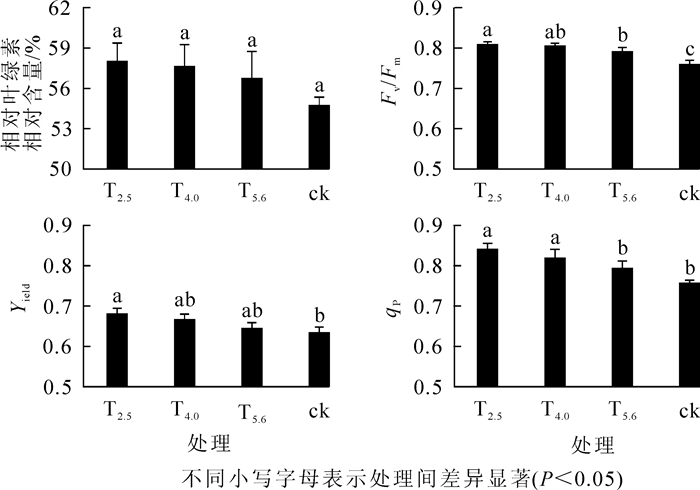
 下载:
下载:



 下载:
下载:
